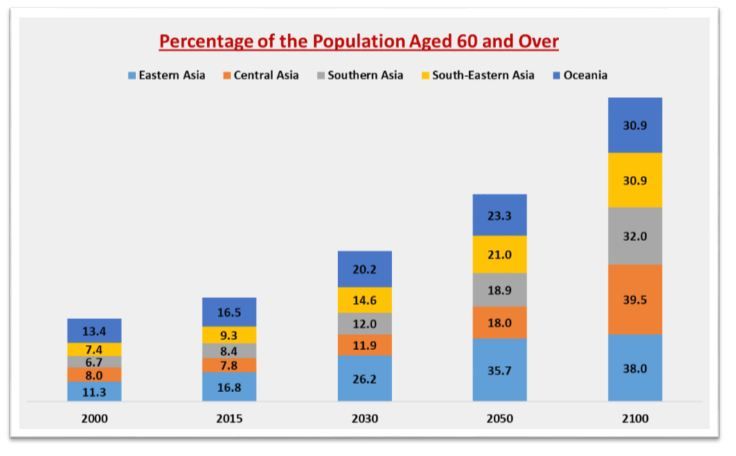
Asia-Pacific An Emerging Market For Ivd Technology
According to estimates from UnivDatos Market Insights report titled In-Vitro Diagnostic Market: Current Scenario and Forecast (2019-2025); the Asia-Pacific IVD market generated revenue of US$ 19.6 billion and is expected to grow at a CAGR of 5.7% during the forecast period 2019-2025, compared to global CAGR of 4.86% during the same timeframe. Economic growth in the Asia-pacific region is fueling investment in national healthcare infrastructures and expanding access to healthcare. China, India and emerging Southeast Asia countries, such as Indonesia, are some of the key markets for the healthcare sector in the region. Thailand is regarded as one of the most preferred places for medical tourism, as the cost of most of the treatment in the country is less, compared to other developed and developing markets. The diagnostics industry is gaining momentum and growing and changing at a faster rate in the Asia-Pacific region. Asia-Pacific presents huge opportunities for most of the In-Vitro Diagnostic segments, well attributed to a deep base of consumers in all socioeconomic strata.
Growth Driver for IVD technology in the Asia-Pacific region:
The Asia-Pacific (APAC) region, home to 60% of the world’s population, contributes a significant share of the global cancer burden. Given the higher prevalence of specific cancers in APAC and distinct Asian patient genotypes, diagnosis and treatment should be tailored to the APAC population. Hence, it can be stated that, opportunities exist for industry players to develop and increase the clinical use of precision oncology therapies and diagnostics to meet the specific needs of the Asia-Pacific market. In 2018, APAC accounted for 60% of the world’s lung cancer cases and deaths, and 75% of all gastric cancer cases and deaths. Oncology spending in Japan and countries such as China and India are expected to hit almost US$ 20 billion by 2022. This is still significantly lower than the US$ 140 billion projected to be spent by the U.S. and the EU-5. Aging populations and changing epidemiological trends in the Asia-Pacific region would create demand for new types of diagnostic tests and business models for industry players, tailored for individual countries and cultures. In a statement Kuldeep Singh, CEO, Biofourmis stated that; “the company sees the interest from payer and providers to assess new innovative methods to deploy and enhance medical diagnostics. China being the most lucrative market will provide huge opportunity for the industry, compared to Australia, where government policy and funding reform is incentivizing precision medicine, Telcos are investing millions to increase coverage to all corners of the country, insurers are investing in new member health services that benefit greatly from enhanced diagnostic capability and the population are one of the highest technology adopters, provides significant opportunity for research and development and new commercial partnerships.”


Asia-Pacific IVD Market; Country-level Analysis:
China: The In-vitro diagnostics (IVD) market in China have witnessed wide growth over the in the past few years and is expected to grow steadily in the next few years, with major growth potential in segments such as infectious disease testing, chronic disease testing and diagnosis in early stages of the disease. Some of the major factors driving the growth of the Chinese IVD market includes rising incidences of chronic lifestyle diseases, public health awareness, growing aging population, the demand for tests in rural areas stimulated by the healthcare reform plan, increasing demand from the middle-class population. However, the low reimbursement rate, absence of quality products by the local companies would limit the market growth. As per the UnivDatos analysis, the Chinese IVD market is expected to grow at a CAGR of 5.3% during the 2019-2025 period.
Japan: Japan’s IVD market is considered the most growing sector after China owing to the increasing aging population and increasing the case of age-related disorder. A rapid increase in the chronic & infectious disease, technological advances, and advent of point of care diagnostics are some of the major factors driving the Japanese IVD market. As per the UnivDatos analysis, the Japanese IVD market is expected to generate revenue of US$ 3.95 billion by 2020.
India: India is regarded as one of the largest markets for IVD in the Asia-Pacific region after China, Japan and South Korea. Indian IVD market is growing at an extraordinary pace and has the potential to emerge as a global manufacturing hub in the medical devices space. Advancement in surgical techniques, evolving trends in diagnostics and in-patient care systems paired with hospital laboratories would be the major factor in designing and marketing strategies of IVD makers in India. As per the UnivDatos analysis, the Indian IVD market would witness the highest CAGR growth of 7.13% during the 2019-2025 period in the Asia-Pacific region.
South Korea: South Korea’s contribution to the growth of the Asia-Pacific IVD market, in terms of revenue and adoption, owing to increasing demand for quality healthcare service in the country. Companies operating in the region have adopted product innovation and new product launches as their key business strategy to ensure their dominance in this market. Some of the key players in the market are Abbott Laboratories, Bio-Rad Laboratories, Inc., Danaher Corporation, Johnson & Johnson, Roche Diagnostics and Siemens Healthcare. As per the UnivDatos analysis, the South Korean IVD market is expected to witness a CAGR growth of 5.3% during the forecast period 2019-2025.
Australia: Australia represents a relatively highly competitive IVD market in the Asia-Pacific region, owing to the presence of established international players, a highly developed export intensive for domestic players, and a highly consolidated clinical lab and testing industry. Approximately half of every dollar spent on clinical testing or pathology services in Australia is provided by the universal public health insurance program, Medicare. As per the UnivDatos analysis, the Australian IVD market is expected to generate revenue of US$ 3.24 billion by 2025.
Indonesia: Indonesia’s clinical testing market is at par with those of its neighbors. The country is the 4th largest in the world in terms of population after China, India, and the USA and an important and prospective market for diagnostics and medical device manufacturers. Only local distribution companies, who have distribution licenses, can engage in IVD sales in Indonesia. Therefore, the assistance of a local legal firm is the best way for a foreign company to set up its operations in the country. As per the UnivDatos analysis, the IVD market in Indonesia generated revenue of ~US$ 240 million in 2018.
Competitive Scenario:
The majority of global players operating in the Asia-Pacific IVD market. Some of the major names in the market include Abbott Laboratories, Bio-Rad Laboratories, Inc., Danaher Corporation, Johnson & Johnson, Roche Diagnostics and Siemens Healthcare. These companies have adopted product innovation and new product launches as their key business strategy to ensure their dominance in this market. Companies are also investing in technology to expand their product portfolio to sustain in the global market.
Conclusion:
Based on the study, new, more user-friendly tests, innovations and technologies, increasing access to healthcare in the region, paired with prevalence of chronic and infectious diseases, the Asia-Pacific IVD market is expected to grow at a brisk pace in years to come. New technologies power some of these innovations. Lab automation tools are bringing efficiencies, though the region is suffering from workforce shortages and skills gaps. Point-of-care diagnostics are increasing access to testing in remote areas. Localization will be key to ensuring that these new technologies are effectively deployed in Asia- Pacific. Diagnostic services would require to be revamped to meet the price points of low-resource settings. Asia has an exquisite emerging R&D ecosystem; this would lead to producing more of its own IVD products and services. Countries like China, Japan and Singapore are going beyond localization and playing a growing role in breakthrough innovation.
Author: Tinku Rai
